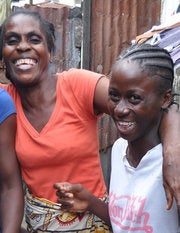
Image courtesy of NYT
As Ebola retreats in West Africa, medical investigators are focused on two women who died of the disease recently. Ruth Tugbah, a 44-year-old food seller with no known risk factors, developed Ebola in Monrovia, Liberia and died in late March. She was the first person to test positive for Ebola more than two weeks after the last known case in the country had been discharged from the hospital. In Freetown, Sierra Leone, a woman who was nine months pregnant and had no known risk factors died of Ebola around the same time.
In both cases, investigators suspected sexual transmission as the source of exposure. In Liberia, laboratory workers detected Ebola genetic material in a semen sample provided by Ms. Tugbah’s boyfriend, an Ebola survivor, 175 days after he developed symptoms. That was 74 days longer than ever found in a survivor before. While the information is consistent with sexual transmission thus far, it is not conclusive, and researchers at the CDC are also trying to determine whether the sample the man provided contained infectious virus or only harmless genetic material. Similarly, officials in Freetown have tried to establish a link to the woman’s husband, Ibrahim Koroma, also an Ebola survivor.
These cases have health groups modifying their advice for survivors, pending the results of various studies taking place in West Africa. The CDC revised its guidelines on Ebola transmission last week, urging survivors to abstain from all forms of sex or use condoms every time “until more information becomes available,” rather than three months as previously recommended. The WHO and Liberia have issued similar recommendations in recent weeks.
Worries over sexual transmission risk add to the stigmatization that Ebola survivors already face. According to Meredith Stakem, a health and nutrition adviser for Catholic Relief Services in West Africa, stigma often accompanies the spread of deadly, poorly understood diseases and the terrified reaction to Ebola recalls the early days of the HIV epidemic. The parallels that experts have already drawn between the two viruses are striking. For example:
- The blaming and shaming of Ebola-infected individuals that took place during the recent outbreak brings to mind the early days of the HIV epidemic when people with HIV were routinely and publicly made into scapegoats.
- The social rejection of health care workers who have provided care to Ebola-infected individuals is reminiscent of the stigmatization faced by health care professionals who cared for HIV-positive individuals and scientists who worked with the virus.
- The debates around quarantine and surveillance of Ebola-infected individuals echo similar discussions that took place during the HIV epidemic, focusing solely on the “isolation” of infectious pathogens and losing sight of the people living with the virus.
Reports are already coming in that highlight the potential for heightened stigmatization, should researchers establish sexual contact as a source of Ebola transmission. Ebola survivors in Sierra Leone have been accused of infecting their partners and detained, despite the apparent lack of specific regulations criminalizing survivors’ having sex. And in November, the Indian Health Ministry held an asymptomatic Ebola survivor who had arrived from Liberia at an airport quarantine center because, even though blood tests were negative, officials found traces of the virus in the man’s semen. The Indian government ended up detaining the man for four months, releasing him only in late March after his latest sample tested negative for Ebola.
There is certainly a need to enhance the public messaging about the potential risks of spreading Ebola through sex. But it must be done in a way that doesn’t provoke a backlash, involve the criminalization of behavior or risk blaming, stigmatizing or isolating survivors further.



